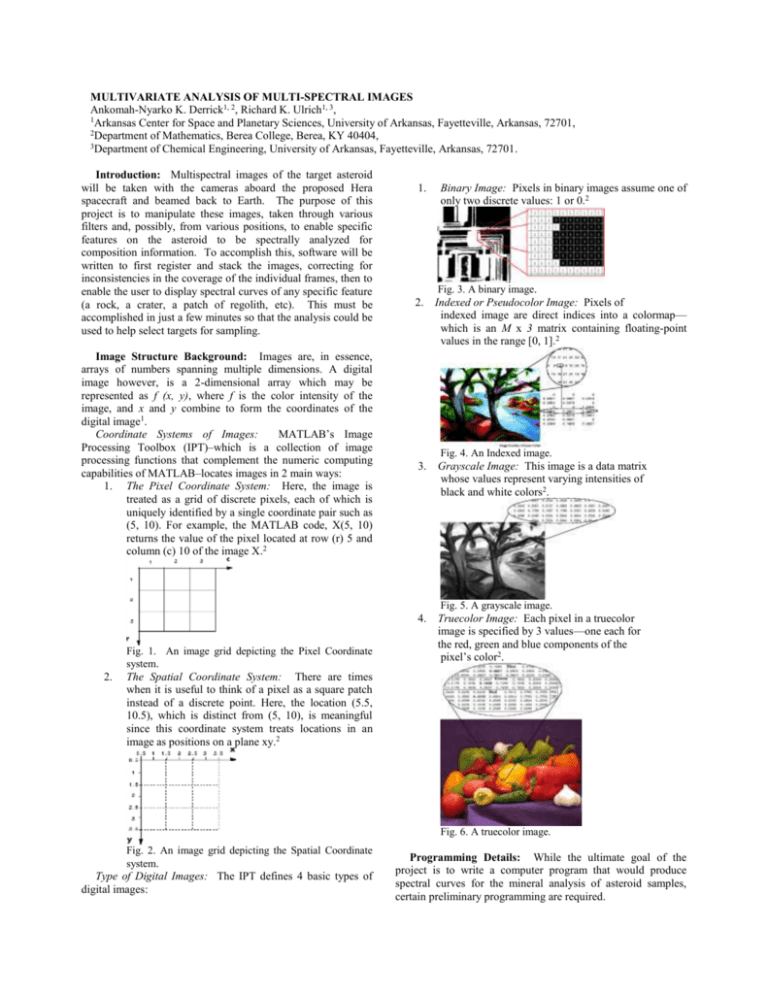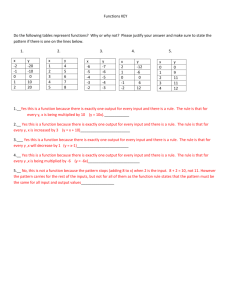
MULTIVARIATE ANALYSIS OF MULTI-SPECTRAL IMAGES
Ankomah-Nyarko K. Derrick1, 2, Richard K. Ulrich1, 3,
1Arkansas Center for Space and Planetary Sciences, University of Arkansas, Fayetteville, Arkansas, 72701,
2Department of Mathematics, Berea College, Berea, KY 40404,
3Department of Chemical Engineering, University of Arkansas, Fayetteville, Arkansas, 72701.
Introduction: Multispectral images of the target asteroid
will be taken with the cameras aboard the proposed Hera
spacecraft and beamed back to Earth. The purpose of this
project is to manipulate these images, taken through various
filters and, possibly, from various positions, to enable specific
features on the asteroid to be spectrally analyzed for
composition information. To accomplish this, software will be
written to first register and stack the images, correcting for
inconsistencies in the coverage of the individual frames, then to
enable the user to display spectral curves of any specific feature
(a rock, a crater, a patch of regolith, etc). This must be
accomplished in just a few minutes so that the analysis could be
used to help select targets for sampling.
Image Structure Background: Images are, in essence,
arrays of numbers spanning multiple dimensions. A digital
image however, is a 2-dimensional array which may be
represented as f (x, y), where f is the color intensity of the
image, and x and y combine to form the coordinates of the
digital image1.
Coordinate Systems of Images:
MATLAB’s Image
Processing Toolbox (IPT)–which is a collection of image
processing functions that complement the numeric computing
capabilities of MATLAB–locates images in 2 main ways:
1. The Pixel Coordinate System: Here, the image is
treated as a grid of discrete pixels, each of which is
uniquely identified by a single coordinate pair such as
(5, 10). For example, the MATLAB code, X(5, 10)
returns the value of the pixel located at row (r) 5 and
column (c) 10 of the image X.2
1.
Binary Image: Pixels in binary images assume one of
only two discrete values: 1 or 0.2
Fig. 3. A binary image.
2. Indexed or Pseudocolor Image: Pixels of
indexed image are direct indices into a colormap—
which is an M x 3 matrix containing floating-point
values in the range [0, 1].2
Fig. 4. An Indexed image.
3.
Grayscale Image: This image is a data matrix
whose values represent varying intensities of
black and white colors2.
4.
Truecolor Image: Each pixel in a truecolor
image is specified by 3 values—one each for
the red, green and blue components of the
pixel’s color2.
Fig. 5. A grayscale image.
Fig. 1. An image grid depicting the Pixel Coordinate
system.
2.
The Spatial Coordinate System: There are times
when it is useful to think of a pixel as a square patch
instead of a discrete point. Here, the location (5.5,
10.5), which is distinct from (5, 10), is meaningful
since this coordinate system treats locations in an
image as positions on a plane xy.2
Fig. 6. A truecolor image.
Fig. 2. An image grid depicting the Spatial Coordinate
system.
Type of Digital Images: The IPT defines 4 basic types of
digital images:
Programming Details: While the ultimate goal of the
project is to write a computer program that would produce
spectral curves for the mineral analysis of asteroid samples,
certain preliminary programming are required.
First Preliminary Program — Registration of Images:
Images obtained from the Hera Mission’s Infrared camera are
color intensity maps of the scene for that particular color.
However, since the computer screen can only display images in
tricolor mode—combination of red, green and blue—it
triplicates the intensities onto three layers and treats it as a
three-color image for display. Since each pixel has the same
color intensity for R, G and B, it displays as shades of gray. As
such a pixel located in row 5 and column 10 of a color intensity
image whose value is 255 would be assigned three 255’s, each
for the red, green and blue display color modes. In our image
analysis, we don’t want this duplication so the two other
redundant intensities are deleted for each pixel in a displayed
image. Thus all color intensity images are reduced from 3layers to a single-layered color intensity images for the specific
color of that filter. Differences in camera angle, distance and
orientation, and differences in wavelengths of the filters through
which grayscale images are taken, all contribute to producing
images of the same scene but with different coordinate systems.
These images therefore must be registered to so that they all
bear a common coordinate system. One of the single-layered
color intensity images (typically the one taken through the filter
with the shortest wavelength) is selected as a reference or base
image. The IPT supports image registration based on control
points—a subset of pixels whose locations in any two images
that are being registered are known or can be determined
interactively by means of the control points select toolbox.
Once a sufficient number of control points have been selected,
the IPT function cpt2form can be used to fit a specified type of
spatial transformation to the control points until both images are
aligned.
a
b
c
Fig. 7. Image Registration based on control points
(a) Base image, (b) Image to be registered, (c) Image in (b)
registered according to the coordinate system of the image in (a)
Second Preliminary Program – Stacking and display of
Images: After all the individual images are registered with
respect to the coordinate system of the base image, they are
stacked as an M x N x Z matrix where M and N are the numbers
of the Y and X pixels contained in each image grid, and Z is the
total number of images being worked on. Z is also equal to the
number of filters used to form the image. Images typically end
up with an increase in the number of original pixels after they
are registered. As such all images (registered images and the
base image) are padded with white or black space, using the
IPT function padarray, until they all contain the same number
of pixels. It is undesirable for pixels to be lost in processing
since they contain information. By either manipulating matrix
indices or by using the IPT function cat—a function which
concatenates arrays according to specified dimensions—these
same-sized registered images are stacked Z-deep from the
shortest wavelength to the longest wavelength along the third
dimension. As stated earlier, computer screens can only display
images as a combination of three colors, in other words,
computer screens can only show images which are 3 color
intensities deep, typically R, G and B. Hence if there are more
than 3 layers in the stacked image (i.e. Z is more than 3), 3
images whose wavelengths are approximately similar to those
of red, green and blue are chosen from the M x N x Z cuboidal
stack to generate an M x N x 3 stack which can be displayed on
a computer screen. Since the human eye can only detect colors
between wavelengths of 380 nm and 780 nm, the M x N x 3
would be displayed as a falsecolor image—an image whose
colors represent intensities outside the visible portion of the
electromagnetic spectrum. This is because about half or more of
the grayscale images would be taken in infrared wavelengths
ranging from 750 nm to 1009 nm.
a
b
Fig. 8. Display of the same image in different wavelength
combinations
(a) A falsecolor image obtained from a combination of wavelengths
436 nm (blue), 904 nm (green) and 1009 nm (red)
(b) A truecolor image obtained from a combination of wavelengths
475 nm (blue), 510 nm (green) and 650 nm (red)
Core program – Display of Spectral Intensity distribution:
Once images have been registered, stacked and displayed,
MATLAB was used to design a graphics user interface that
would display plots of Z layers against their respective
intensities for any one pixel located within the M x N x Z
coordinate system or for any region of pixels that may be
represented as a patch of regolith, a crater or a rock. All spectral
curves should be produced as a result of a user-interactive
process, i.e. mouse movements.
Control – FTIR Rock Sample Analysis: As a comparison,
samples on Earth, which are suspected to contain similar
mineral contents as the asteroid samples, would be fed through
a Fourier Transform Infrared Spectrometer (FTIR) to obtain
spectrograms for comparison with the images from Hera.
Conclusion: The MATLAB-generated spectral distributions
from the Hera images would be compared to the FTIRgenerated spectrograms to ascertain which samples on Earth
bear semblance in terms of mineral composition with the
asteroid samples.
Acknowledgements: Funding was sourced from NASA
through the Arkansas Center for Space and Planetary Sciences.
MATLAB and IPT software including access to a laptop were
provided by the University of Arkansas’s Chemical Engineering
department.
References: [1] Gonzalez, Rafael et al. Digital Image
Processing Using MATLAB. Prentice Hall, 2003. [2] Image
Processing Toolbox. http://www.mathworks.com/access/
helpdesk/help/toolbox/images/ [3] Gilat, Amos. MATLAB: An
Introduction With Applications. John Wiley & Sons, Inc., 2005.
[4] Hanselman, Duane and Littlefield, Bruce. Mastering
MATLAB 7. Pearson Prentice Hall, 2005.








